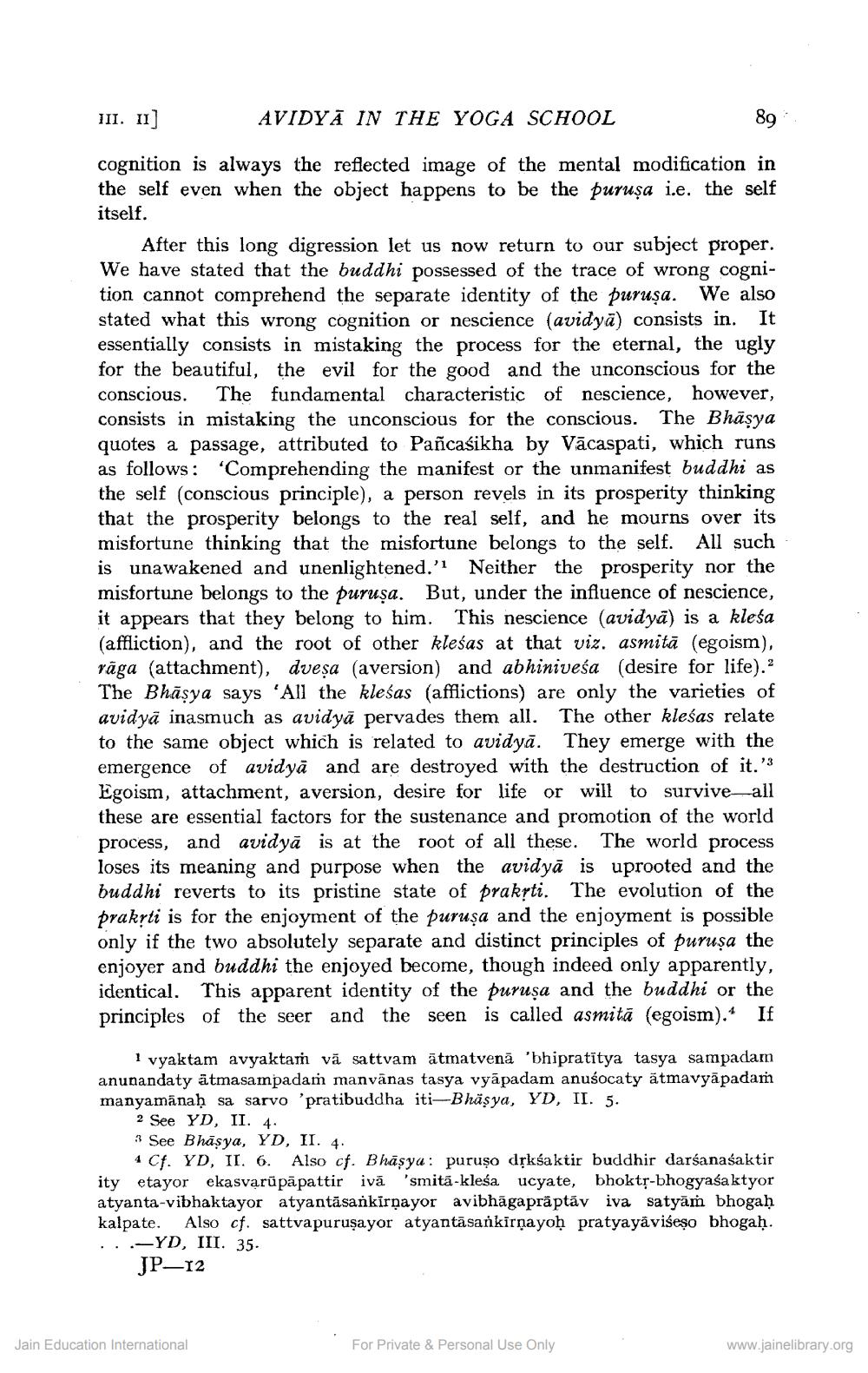________________
III. II]
AVIDYA IN THE YOGA SCHOOL
89
cognition is always the reflected image of the mental modification in the self even when the object happens to be the puruşa i.e. the self itself.
conscious.
After this long digression let us now return to our subject proper. We have stated that the buddhi possessed of the trace of wrong cognition cannot comprehend the separate identity of the purușa. We also stated what this wrong cognition or nescience (avidya) consists in. It essentially consists in mistaking the process for the eternal, the ugly for the beautiful, the evil for the good and the unconscious for the The fundamental characteristic of nescience, however, consists in mistaking the unconscious for the conscious. The Bhāṣya quotes a passage, attributed to Pañcaśikha by Vacaspati, which runs as follows: 'Comprehending the manifest or the unmanifest buddhi as the self (conscious principle), a person revels in its prosperity thinking that the prosperity belongs to the real self, and he mourns over its misfortune thinking that the misfortune belongs to the self. All such is unawakened and unenlightened." Neither the prosperity nor the misfortune belongs to the puruşa. But, under the influence of nescience, it appears that they belong to him. This nescience (avidya) is a klesa (affliction), and the root of other klesas at that viz. asmitā (egoism), raga (attachment), dveṣa (aversion) and abhiniveśa (desire for life).2 The Bhasya says 'All the klesas (afflictions) are only the varieties of avidya inasmuch as avidya pervades them all. The other klesas relate to the same object which is related to avidya. They emerge with the emergence of avidya and are destroyed with the destruction of it."3 Egoism, attachment, aversion, desire for life or will to survive all these are essential factors for the sustenance and promotion of the world process, and avidya is at the root of all these. The world process loses its meaning and purpose when the avidya is uprooted and the buddhi reverts to its pristine state of prakṛti. The evolution of the prakṛti is for the enjoyment of the puruşa and the enjoyment is possible only if the two absolutely separate and distinct principles of puruşa the enjoyer and buddhi the enjoyed become, though indeed only apparently, identical. This apparent identity of the puruşa and the buddhi or the principles of the seer and the seen is called asmita (egoism). If
4
1 vyaktam avyaktam va sattvam atmatvenā 'bhipratītya tasya sampadam anunandaty atmasampadaṁ manvānas tasya vyapadam anuśocaty ätmavyāpadam manyamanaḥ sa sarvo 'pratibuddha iti-Bhäşya, YD, II. 5.
2 See YD, II. 4.
3 See Bhasya, YD, II. 4.
4 Cf. YD, II. 6. Also cf. Bhaṣya: puruso drksaktir buddhir darśanaśaktir ity etayor ekasvarüpāpattir ivā 'smita-kleśa ucyate, bhoktṛ-bhogyaśaktyor atyanta-vibhaktayor atyantasankirṇayor avibhāgapräptāv iva satyam bhogaḥ kalpate. Also cf. sattvapuruṣayor atyantasankirṇayoḥ pratyayaviseṣo bhogaḥ. -YD, III. 35. JP-12
Jain Education International
For Private & Personal Use Only
www.jainelibrary.org




